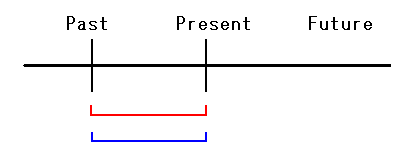EnglishCafe
| previous page | EnglishCafe Top | following page |
 |
| 3.2. The differences between the past tense and the present perfect form (Summary of this chapter) This section compares the past tense and the present perfect form (PrPF). The events are occurred in the past with the two forms, which form is used depends on the speaker's feeling at an utterance. Completive and Resultative in 3.1.1, the differences of the two are explained. See the following examples. (19) a. The clock struck ten. b. The clock has just struck ten. (19a) is the past tense, (19b) is PrPF. These are shown in the figures as follows. (20) a. Past form  b. Present perfect form  As mentioned above, the past tense merely treats the event as the past, but PrPF has the mental contact with the present.
See also the examples. (21) a. We lived in Hakodate for five years. b. We have lived in Hakodate for five years. For five years of (21a) is expressed in a certain past, that is, the speaker does not live in Hakodate in the present on the meaning. But in (21b), for five years is continued to the present. (22) a. We lived in Hakodate for five years.  b. We have lived in Hakodate for five years.  The red lines in the two figures are the duration of the event. In (22a), the red line is not continued to the present, it means s/he moved from Hakodate at a certain past. When s/he has the past in mind, the past tense is used, but when s/he has the present in mind, PrPF is used. See the last examples. (23) a. Did you ever meet john? b. Have you ever met John? Each of the sentences asks whether you meet John or not. If you ask it, which form do you choose? As mentioned above, the choice depends on the speaker's feeling. That is to say, if s/he has a past in mind at the utterance, (23a) is chose, but if not, (23b) is chosen.
|
| previous page | EnglishCafe Top | following page |
| Copyright (c) EnglishCafe : Unapproved printing of the text and figure in this site is forbidden. |

